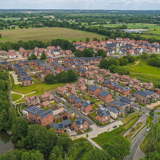8 things planners need to know about biodiversity net gain
In March 2022, our chairman, Professor David Hill took part in a webinar in partnership with environmental barrister Nina Pindham, of No5 Chambers, Richard Blyth, Head of Policy and Practice at Royal Town Planning Institute, and Simon Wicks, Deputy Editor of The Planner. Over 2,000 planners tuned in - here is our round-up of David’s advice and our top takeaways from the event. Download all 56 questions here.
1. The Environment Act brought Biodiversity Net Gain (BNG) into law. Planners will have to implement it on the ground
BNG, as enshrined in the Environment Act 2021, enables us to get finance into the natural environment. Under the Environment Act, planning permission for new developments - whether through the Town & Country Planning Act or national infrastructure projects - have to demonstrate how a minimum of 10% BNG can be achieved, either through onsite, offsite offsetting or through a combination of the two.
2. A developer must measure BNG and report and measure this via a national register
Firstly, the developer, through his environmental consultants, will apply the Defra Metric 3.0 to the particular development site and use this to calculate the number of biodiversity units that are present there. So, for example, if they calculate that 100 units are on the site, this has to be increased by a minimum of 10%. However, the planning authority can decide that this needs to be increased by a 10, 20, or even a 25% gain in their particular area. The uplift gain is known as the BNG requirement.
If they calculate that 100 biodiversity units are on the site, this has to be increased by a minimum of 10%. However, the planning authority can decide that this needs to be increased by a 10, 20, or even a 25% gain in their particular area.
The developer then applies the mitigation hierarchy. Some of the overall BNG requirement is retained and provided onsite, but we believe the remainder, which could be considerable, will need to be placed off-site into either a bespoke offset project using the developer’s land or by buying BNG Credits offset by Habitat Bank schemes such as ours.
The developer’s BNG net gain plan has to be transparent, and the developer has to demonstrate how BNG will be delivered and maintained for a minimum of 30 years. If there are no local markets for BNG Credits available to purchase then as a last resort credits can be bought from Natural England. However, this is likely to be a time-limited solution, until a local market infrastructure can be delivered.
All on or offsite BNG Credits must be registered on the Defra register (on-site might be registered with the LPA), which Defra and Natural England are working on.
3. LPAs face conflicts of interest if they try and sell BNG Credits themselves
LPAs could bring forwards their own sites for BNG Credits, but it would have to be done through a commercial vehicle, as with other income-generating exercises applied by local councils.
If attempting to deliver BNG on their land, LPAs must be mindful of state aid rules and not seen to be anti-competitive. They must register sites and underwrite and guarantee funding for them for 30 years before they can sell credits to a developer. They must ensure the credit scheme is legally compliant to make sure there is no risk of a legal challenge further down the line.
There is a risk of conflicts of interest where an LPA receives funding from the people they regulate. LPA sites would have to operate strategically, and LPAs need the capacity to assess the developer’s BNG plans. Or they can save all the hassle and use a Habitat Bank provider, such as us.

4. Planners will have increased powers to enforce BNG compliance
In terms of delivery, it’s critical that developers transparently apply the Defra metric and that the BNG gain plan is clear, to avoid a legal challenge to the developer further down the line. The developer can decide on the amount of on and offsite BNG they deliver but they must guarantee for 30 years the funding for the management of the site. They can’t simply pass on the liability of the site to a management company or a resident’s association (unless that is fully funded for 30 years and such bodies accept the delivery liabilities for that period of time).
In terms of delivery, it’s critical that developers transparently apply the Defra metric and that the BNG gain plan is clear, to avoid a legal challenge to the developer further down the line.
The onsite model also requires 30 years of monitoring and reporting, plus site management and delivery. There is a substantial commitment required from developers and at the moment, there is not much clarity from developers as to how they will do this.
There will be increased powers to LPAs to enforce compliance if there is a failure to deliver and we think onsite, as with offsite, is likely to need accreditation and certification. So, there are a range of constraints to onsite - not least because there is a risk onsite will not be delivered over 30 years. Alternatively, developers can look for offsite provision, for example purchasing offsite credits through Habitat Banks.
5. LPAs can bring forward land for Habitat Banks
In terms of landowners, farmers, conservation bodies, LPAs and developers, they can all bring forward sites for BNG. They can bring forward schemes themselves or secure guaranteed 30 years of funding by engaging with a company like ourselves to help them deliver Habitat Banks, at no risk to themselves.
We’ve raised significant funding to work with LPAs to provide more than 4,000 hectares over the next three years to deliver Habitat Banks, enabling developers to become compliant. We aim to put at least one Habitat Bank in each LPA area to satisfy that demand.
6. Habitat Banks uplift the biodiversity value of existing land
The biggest uplift in biodiversity is where intensively farmed arable land, usually grade 3 or 4 arable land, is managed as species-rich wildflower meadows, other species-rich grasslands, woodland, wetland or rewilded areas in some cases. The uplift through the creation of the Habitat Banks and ongoing management gives us the credits that we can sell to buyers.

7. Habitat Banks easily allow LPAs to discharge their duty in terms of BNG reporting
The most important consideration is that the BNG credit has to be secured before the development can begin. This gives a guarantee to the LPA that the BNG is going to work. So, for example, we won’t agree to a phased approach where a developer only wants to purchase credits once the development is underway. That is consistent with our business offering because we would not wish to carry the risk, credit demand is expected to be high and we need a volume of sales in order to satisfy our investment. Further, the costs to developers is minimal by comparison to using up developable area, so we consider it appropriate for credits to be secured upfront, prior to the start of the development.
We undertake all the correspondence with the LPA and set up monitoring and reporting which is provided to the LPA in order that they can discharge their duty in terms of BNG reporting.
8. Habitat Banks de-risk the BNG process for planning authorities
The Habitat Bank model de-risks the whole process for LPAs. They don’t need to find the capacity to deliver and monitor BNG; it’s at zero risk from judicial review because we take on the delivery liability; there is no need for them to underwrite sites for 30 years of funding; they have independence from objections that might cause political issues in their areas and there is no need to set up a commercial entity to transact deals.
They don’t need to find the capacity to deliver and monitor BNG; it’s at zero risk from judicial review because we take on the delivery liability; there is no need for them to underwrite sites for 30 years of funding.
In short
We believe that for nature, Habitat Banks deliver at scale. Not small, fragmented pockets within the development site boundary that deliver very little for biodiversity. Nor do these fragmented areas have any longevity (because they are unlikely to be managed effectively for 30 years), and nor do they comply with the Lawton principles of bigger, better and joined. Instead, we are aiming to create large protected and fully funded sites that have maximum biodiversity value with a guaranteed future.
Download all 56 questions and answers here.
For planners
For LPAs Habitat Banks provide a streamlined and robust mechanism, compliant with the Environment Act 2021 and the National Planning Policy Framework. There is no cost to the LPA or taxpayer and it removes their liability if they were looking at setting up their own Habitat Banks in the future. It’s a win-win and at no risk to the local authority.
For more information, please get in touch with our team.
For developers
For developers, it gives them visibility in the planning system, and they don’t have the liability of looking after areas within development sites for 30 years nor fund their management long-term. You can’t do BNG very easily on-site commercially, there just isn’t the space.
And it’s of minimal cost. BNG Credits cost in the region of less than 0.5% of gross development value and we end up with bigger and better-scaled sites that bring real biodiversity restoration and contribute towards the nature recovery network that is an ambition of the government.
For more information, please get in touch with our team and for BNG Credit enquiries, please complete our BNG Credit request developer page form.
For landowners
For the landowner, we give guaranteed payments, we 100% support them through the process and the sites provide a secure income diversification.
For more information, please get in touch with our team and if you are a landowner interested in Habitat Bank creation, please complete our land registry landowners dropdown form to get started.




About the author
Environment Bank